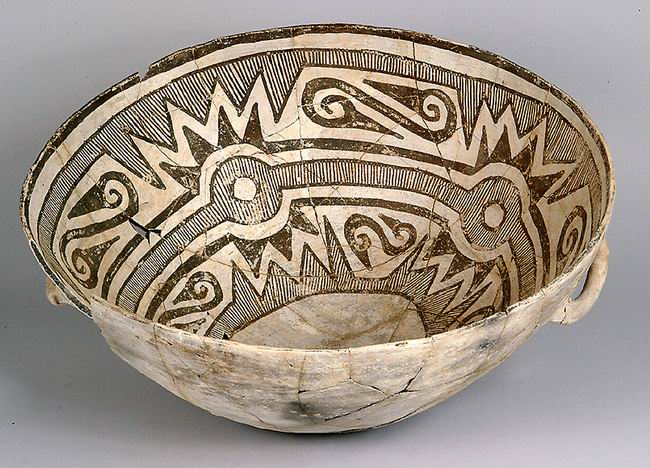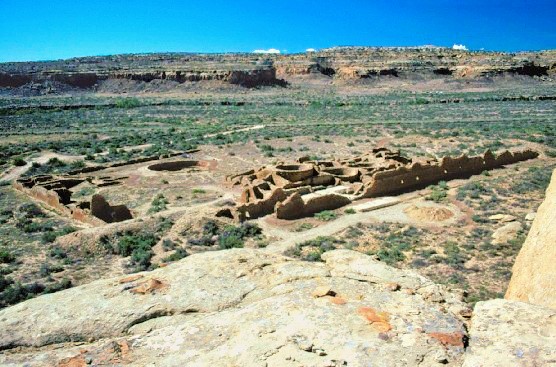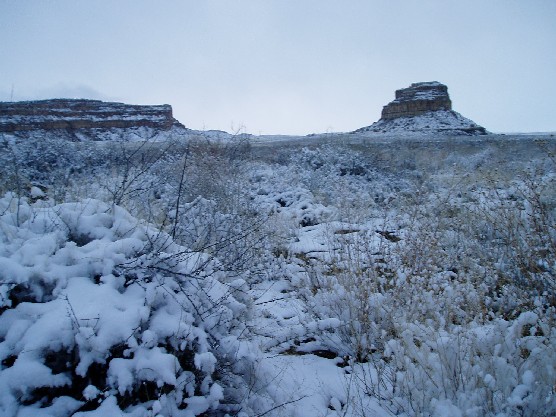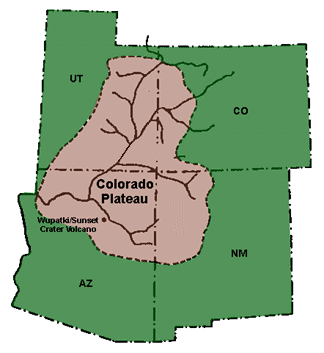|
McElmo Phase
McElmo Phase refers to a period in the late 11th and early 12th centuries, when drastic changes in ceramics and masonry techniques in Chaco Canyon appeared. During this period the Ancestral Puebloans living in the canyon started using painted black-on-white pottery versus their standard grey ware, and the masonry and layout of great houses built during the McElmo phase, which was the last major construction era in the canyon, differ significantly from those built during the early parts of the Bonito Phase (850 to 1140), which overlaps with the McElmo Phase. Archeologists initially suggested that the McElmo influence was brought to Chaco Canyon by immigrants from Mesa Verde, but subsequent research suggests that the developments were of local origin. Archeologist R. Gwinn Vivian notes, "The jury is still out on this question, a problem that poses intriguing possibilities for future work." Chetro Ketl A smaller square building, known as the Talus Unit, with a McElmo style floor plan ... [...More Info...] [...Related Items...] OR: [Wikipedia] [Google] [Baidu] |
McElmo Style Masonry At Kin Kletso By RO
McElmo Phase refers to a period in the late 11th and early 12th centuries, when drastic changes in ceramics and masonry techniques in Chaco Canyon appeared. During this period the Ancestral Puebloans living in the canyon started using painted black-on-white pottery versus their standard grey ware, and the masonry and layout of great houses built during the McElmo phase, which was the last major construction era in the canyon, differ significantly from those built during the early parts of the Bonito Phase (850 to 1140), which overlaps with the McElmo Phase. Archeologists initially suggested that the McElmo influence was brought to Chaco Canyon by immigrants from Mesa Verde Mesa Verde National Park is an American national park and UNESCO World Heritage Site located in Montezuma County, Colorado. The park protects some of the best-preserved Ancestral Puebloan archaeological sites in the United States. Established ..., but subsequent research suggests that the developments wer ... [...More Info...] [...Related Items...] OR: [Wikipedia] [Google] [Baidu] |
Bowl Chaco Culture NM USA
A bowl is a typically round dish or container generally used for preparing, serving, or consuming food. The interior of a bowl is characteristically shaped like a spherical cap, with the edges and the bottom forming a seamless curve. This makes bowls especially suited for holding liquids and loose food, as the contents of the bowl are naturally concentrated in its center by the force of gravity. The exterior of a bowl is most often round but can be of any shape, including rectangular. The size of bowls varies from small bowls used to hold a single serving of food to large bowls, such as punch bowls or salad bowls, that are often used to hold or store more than one portion of food. There is some overlap between bowls, cups, and plates. Very small bowls, such as the tea bowl, are often called cups, while plates with especially deep wells are often called bowls. In many cultures bowls are the most common kind of vessel used for serving and eating food. Historically small bowls w ... [...More Info...] [...Related Items...] OR: [Wikipedia] [Google] [Baidu] |
Chaco Culture National Historical Park
Chaco Culture National Historical Park is a United States National Historical Park in the American Southwest hosting a concentration of pueblos. The park is located in northwestern New Mexico, between Albuquerque and Farmington, in a remote canyon cut by the Chaco Wash. Containing the most sweeping collection of ancient ruins north of Mexico, the park preserves one of the most important pre-Columbian cultural and historical areas in the United States. Between AD 900 and 1150, Chaco Canyon was a major center of culture for the Ancestral Puebloans. Chacoans quarried sandstone blocks and hauled timber from great distances, assembling fifteen major complexes that remained the largest buildings ever built in North America until the 19th century. Evidence of archaeoastronomy at Chaco has been proposed, with the "Sun Dagger" petroglyph at Fajada Butte a popular example. Many Chacoan buildings may have been aligned to capture the solar and lunar cycles, requiring generations of astro ... [...More Info...] [...Related Items...] OR: [Wikipedia] [Google] [Baidu] |
Ancestral Puebloans
The Ancestral Puebloans, also known as the Anasazi, were an ancient Native American culture that spanned the present-day Four Corners region of the United States, comprising southeastern Utah, northeastern Arizona, northwestern New Mexico, and southwestern Colorado. They are believed to have developed, at least in part, from the Oshara tradition, which developed from the Picosa culture. The people and their archaeological culture are often referred to as ''Anasazi'', meaning "ancient enemies", as they were called by Navajo. Contemporary Puebloans object to the use of this term, with some viewing it as derogatory. The Ancestral Puebloans lived in a range of structures that included small family pit houses, larger structures to house clans, grand pueblos, and cliff-sited dwellings for defense. They had a complex network linking hundreds of communities and population centers across the Colorado Plateau. They held a distinct knowledge of celestial sciences that found form in ... [...More Info...] [...Related Items...] OR: [Wikipedia] [Google] [Baidu] |
Great House (pueblo)
A great house is a large, multi-storied Ancestral Puebloan structure; they were built between 850 and 1150. Whereas the term "great house" typically refers to structures in Chaco Canyon, they are also found in more northerly locations in the San Juan Basin, including the Mesa Verde region. The purpose of the structures is unclear, but may have been to house large numbers of people, religious leaders, or royalty. They were designed and constructed to provide shelter to inhabitants in an arid climate and had protective walls and small windows. History and purpose Great house construction flourished during the late 11th and early 12th centuries, and may have begun as early as 800. Mesa Verdeans usually built their great houses on the site of older villages. The earliest examples of structures similar to great houses have been found along the Mimbres River in New Mexico. Archeologists differ as to their purpose, but they might have been residences for large numbers of people, o ... [...More Info...] [...Related Items...] OR: [Wikipedia] [Google] [Baidu] |
Bonito Phase
Bonito Phase is an archeological term that refers to the period between 900 and 1140 CE, during which the Ancestral Puebloans in the Chaco Canyon area constructed numerous great houses. The system is divided into three parts: the Early Bonito phase from 900 to 1040; the Classic Bonito phase from 1040 to 1100, and the Late Bonito phase from 1100 to 1140. When the system was created in the 1980s, it was thought that construction at Pueblo Bonito Pueblo Bonito (Spanish for ''beautiful town'') is the largest and best-known great house in Chaco Culture National Historical Park, northern New Mexico. It was built by the Ancestral Puebloans who occupied the structure between AD 828 and 1126. ... began around 920, but it is now known that building at the great house started almost one hundred years earlier, . References Citations Bibliography * {{authority control Ancestral Puebloans Chaco Canyon Chaco Culture National Historical Park Archaeological sites in New Mexico ... [...More Info...] [...Related Items...] OR: [Wikipedia] [Google] [Baidu] |
Mesa Verde National Park
Mesa Verde National Park is an American national park and UNESCO World Heritage Site located in Montezuma County, Colorado. The park protects some of the best-preserved Ancestral Puebloan archaeological sites in the United States. Established by Congress and President Theodore Roosevelt in 1906, the park occupies near the Four Corners region of the American Southwest. With more than 5,000 sites, including 600 cliff dwellings, it is the largest archaeological preserve in the United States. Mesa Verde (Spanish for "green table", or more specifically "green table mountain") is best known for structures such as Cliff Palace, thought to be the largest cliff dwelling in North America. Starting BC Mesa Verde was seasonally inhabited by a group of nomadic Paleo-Indians known as the Foothills Mountain Complex. The variety of projectile points found in the region indicates they were influenced by surrounding areas, including the Great Basin, the San Juan Basin, and the Rio Grande V ... [...More Info...] [...Related Items...] OR: [Wikipedia] [Google] [Baidu] |
Chetro Ketl
Chetro Ketl is an Ancestral Puebloan great house and archeological site located in Chaco Culture National Historical Park, New Mexico, United States. Construction on Chetro Ketl began and was largely complete by 1075, with significant remodeling occurring in the early and mid-1110s. Following the onset of a severe drought, most Chacoans emigrated from the canyon by 1140; by 1250 Chetro Ketl's last inhabitants had vacated the structure. The great house was rediscovered in 1823 by the Mexican governor of New Mexico, José Antonio Vizcarra, and in 1849 Lieutenant James Simpson of the United States Army Corps of Engineers documented the major ruins in Chaco Canyon. Edgar L. Hewett, the director of the first archeological field school in the canyon, conducted excavations of Chetro Ketl during 1920 and 1921, and again between 1929 and 1935. Chaco scholars estimate that it required more than 500,000 man-hours, 26,000 trees, and 50 million sandstone blocks to erect Chetro Ketl. ... [...More Info...] [...Related Items...] OR: [Wikipedia] [Google] [Baidu] |
Archaeological Sites In New Mexico
Archaeology or archeology is the scientific study of human activity through the recovery and analysis of material culture. The archaeological record consists of artifacts, architecture, biofacts or ecofacts, sites, and cultural landscapes. Archaeology can be considered both a social science and a branch of the humanities. It is usually considered an independent academic discipline, but may also be classified as part of anthropology (in North America – the four-field approach), history or geography. Archaeologists study human prehistory and history, from the development of the first stone tools at Lomekwi in East Africa 3.3 million years ago up until recent decades. Archaeology is distinct from palaeontology, which is the study of fossil remains. Archaeology is particularly important for learning about prehistoric societies, for which, by definition, there are no written records. Prehistory includes over 99% of the human past, from the Paleolithic until the advent o ... [...More Info...] [...Related Items...] OR: [Wikipedia] [Google] [Baidu] |
Chaco Canyon
Chaco Culture National Historical Park is a United States National Historical Park in the American Southwest hosting a concentration of pueblos. The park is located in northwestern New Mexico, between Albuquerque and Farmington, in a remote canyon cut by the Chaco Wash. Containing the most sweeping collection of ancient ruins north of Mexico, the park preserves one of the most important pre-Columbian cultural and historical areas in the United States. Between AD 900 and 1150, Chaco Canyon was a major center of culture for the Ancestral Puebloans. Chacoans quarried sandstone blocks and hauled timber from great distances, assembling fifteen major complexes that remained the largest buildings ever built in North America until the 19th century. Evidence of archaeoastronomy at Chaco has been proposed, with the "Sun Dagger" petroglyph at Fajada Butte a popular example. Many Chacoan buildings may have been aligned to capture the solar and lunar cycles, requiring generations of astron ... [...More Info...] [...Related Items...] OR: [Wikipedia] [Google] [Baidu] |
Colorado Plateau
The Colorado Plateau, also known as the Colorado Plateau Province, is a physiographic and desert region of the Intermontane Plateaus, roughly centered on the Four Corners region of the southwestern United States. This province covers an area of 336,700 km2 (130,000 mi2) within western Colorado, northwestern New Mexico, southern and eastern Utah, northern Arizona, and a tiny fraction in the extreme southeast of Nevada. About 90% of the area is drained by the Colorado River and its main tributaries: the Green, San Juan, and Little Colorado. Most of the remainder of the plateau is drained by the Rio Grande and its tributaries. The Colorado Plateau is largely made up of high desert, with scattered areas of forests. In the south-west corner of the Colorado Plateau lies the Grand Canyon of the Colorado River. Much of the Plateau's landscape is related to the Grand Canyon in both appearance and geologic history. The nickname "Red Rock Country" suggests the brightly colored ... [...More Info...] [...Related Items...] OR: [Wikipedia] [Google] [Baidu] |



.jpg)




.jpg)

